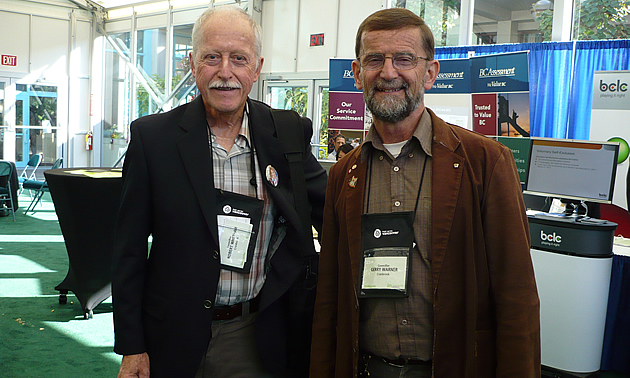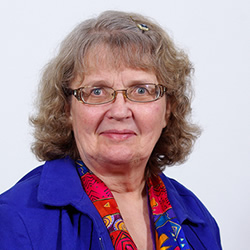The mid-size advantage
Smaller communities have an advantage in luring, and retaining, skilled workers

City of Cranbrook councillors Bob Whetham (L) and Gerry Warner were among those who attended the Mid-Sized Communities Forum, just one session at the fall UBCM convention in Victoria, B.C. Mid-sized communities were defined as those with a population of between 5,000 and 20,000. — Sandra Albers photo
Mid-sized communities—which include many of the towns and cities in the East and West Kootenay—have a distinct advantage over large cities during an economic downturn.
That was the message of Dr. Paul Kershaw, one of the speakers at the Mid-Sized Communities Forum staged at the annual fall convention of the Union of B.C. Municipalities (UBCM) in Victoria. The convention was attended by about 1,500 mayors, councillors, regional district directors and city staff from communities throughout B.C.
Kershaw, who is an assistant professor at the University of British Columbia, began his remarks by pointing out that many people today are facing stalled incomes and a declining standard of living.
He said that the time it takes an average family to save 20 per cent for a down payment on a home has changed dramatically: in 1976, it was five years; today, it is 15 years.
The younger generation, in particular, is feeling the squeeze, since they often carry a student debt load that is also higher than ever.
But "this can be an asset to mid-sized communities," Kershaw said, "because housing is more affordable."
Meeting a need
Kershaw said more and more people are moving around, some to Alberta, and others to smaller communities in B.C., seeking that affordable house with the big yard for their kids.
People today are also squeezed for time, Kershaw noted. Canadians work an average of 300 hours a year more than, for example, the Dutch, he said.
This can also make mid-sized communities more attractive to workers, since it can be possible to live on one income in a smaller town, he said.
Kershaw went on to say that Canada spends less on early childcare and educational services than do most developed countries, meaning people are squeezed for services, as well as time and money. He cheekily calls it the FU (Families Unaffordable) phenomenon.
Speaking to the issue of recruiting and retaining skilled workers at the local government and community level, Kershaw said there are huge costs to filling vacancies. He said it can cost around $1.03 billion to replace 17,000 people or, if amortized over four years, about a quarter of a million dollars.
Yet, Kershaw said, those 17,000 employees might be retained with a simple change in daycare policy. Daycare in Quebec, for example, is available for $7 a day; in the rest of Canada, it costs between $20 and $40 a day.
The changing times
In the '60s and '70s, "the baby boom generation did make sure to create a social policy network (the Canada Pension Plan and the like)," Kershaw said.
"But what have we done since?"
Kershaw said there has been a failure to adapt policies for the under-45 generation, which often values time over getting more "stuff."
He had some recommendations: a better parental leave system; $10-a-day child care; and encouraging longer work lives, but shorter work years. (For example, as the population ages, people might choose to work past retirement, but cut their work week by five hours or so).
"Municipal leaders can lend their voices for a better deal for families," he said.
During the question and answer session following his speech, Kershaw added that about 30 per cent of children start kindergarten with some kind of vulnerability, which can result in jail time, and its associated costs, down the road. He believes we could reduce prison costs by a third by having better early intervention.
He said the poverty rate for younger people is actually much higher than for seniors.
Kershaw further noted that the under-45 crowd tends to be the least engaged politically. He again praised the baby boomers for talking about serious issues (the Vietnam war, for one) amidst all the "sex, drugs and rock and roll" of the '60s era, but feels it is now incumbent on those boomers to encourage the younger folks to get involved in the political process.
To that end, Kershaw said various communities in B.C.—including Cranbrook and Golden—have organized WTF (Where's The Family?) events aimed at sparking interest in advocating for family-friendly policies.
Dr. Kershaw, a highly engaging presenter himself, is available for speaking engagements.






Comments